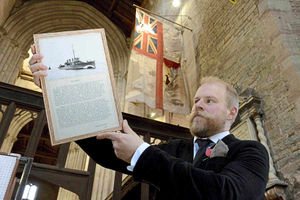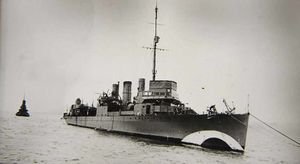HMS Ludlow: Church flags up call to save Navy ensign
At low tide the remains of a warship with a long history of service can still be seen poking above the water line off the coast of Scotland.

But the flag of the HMS Ludlow returned much closer to home after the Second World War, and had been hanging ever since on the wall in the south Shropshire town's Church of St Laurence.
It is only fitting, as it was made by the ladies of the town especially for the Caldwell class destroyer, which fought German submarines in the First World War and acted as an escort vessel from 1940 to 1945.
Now the flag which acted as the destroyer's ensign – a ship's largest flag flown at the rear to denote nationality – is in danger of crumbling away altogether and going the way of the vessel it was once attached to.
A crowdfunding drive has now been started to raise the final few thousand pounds needed for urgent action to preserve the fine silk fabric.
Shaun Ward, parish project director at St Laurence's Church, said: "The ensign was made in silk by the ladies of Ludlow when the ship was named and adopted by the town in 1940.
"We now urgently need to raise the remaining funds needed to conserve this ensign and provide a clear display case to preserve it for future generations.
"Due to the delicate nature of the fabric, it has suffered considerably in the last few years.
"Unless we act this year, a significant portion may be lost.
"We hope to secure some grant aid towards this important work. A number of Royal Naval Associations from across the UK have made donations.
"We now need to raise in the region of £3,000. Every penny counts!" he said.

The HMS Ludlow flag was actually the third ship to bear the name.
She was built in 1917 in the United States, and was originally known as the USS Stockton, acting as an escort to the American Expeditionary Force – and used on anti-submarine duties, operating out of Queenstown, Ireland.
During that time, she engaged an enemy U-boat on at least one occasion while escorting the troopship St Paul on the Queenstown-Liverpool circuit in March 1918, narrowly avoiding being hit by a torpedo.
After World World One she was mothballed until 1940, when she was one of 50 US destroyers exchanged with the UK for naval bases in the Caribbean.
Mr Ward said: "The need for convoy escort vessels was paramount at this stage of World War Two.
"Her new name was chosen as one of a number of towns that exist in the UK, the Commonwealth and the USA.
"She then worked on convoy escort duties between Rosyth, where she was based, and the Thames estuary.
"She was finally paid off in July 1945 having given valuable service in two world wars."
While the ensign flag made its way back to Ludlow, the HMS Ludlow was beached in the Firth of Forth, off Yellowcraigs beach in East Lothian, Scotland.
The ship then suffered the ignoble fate of being used as a rocket target by the Royal Air Force, where it is said the first salvo of rockets hit just below the water line and sank her.
Her remains are still there, while a model of her is in Ludlow Museum.
Anyone wishing to make a contribution to the fund to preserve the ensign can donate online at www.justgiving.com/campaigns/charity/stlaurences/hmsludlow or drop an envelope marked "HMS Ludlow" in the donation boxes in St Laurence's Church or via the Parish Office, No.2 College Street.
Cheques should be made payable to Ludlow PCC – HMS Ludlow Appeal.
UK taxpayers can select Gift Aid for their donation meaning the appeal can claim an extra 25p for every pound donated.





